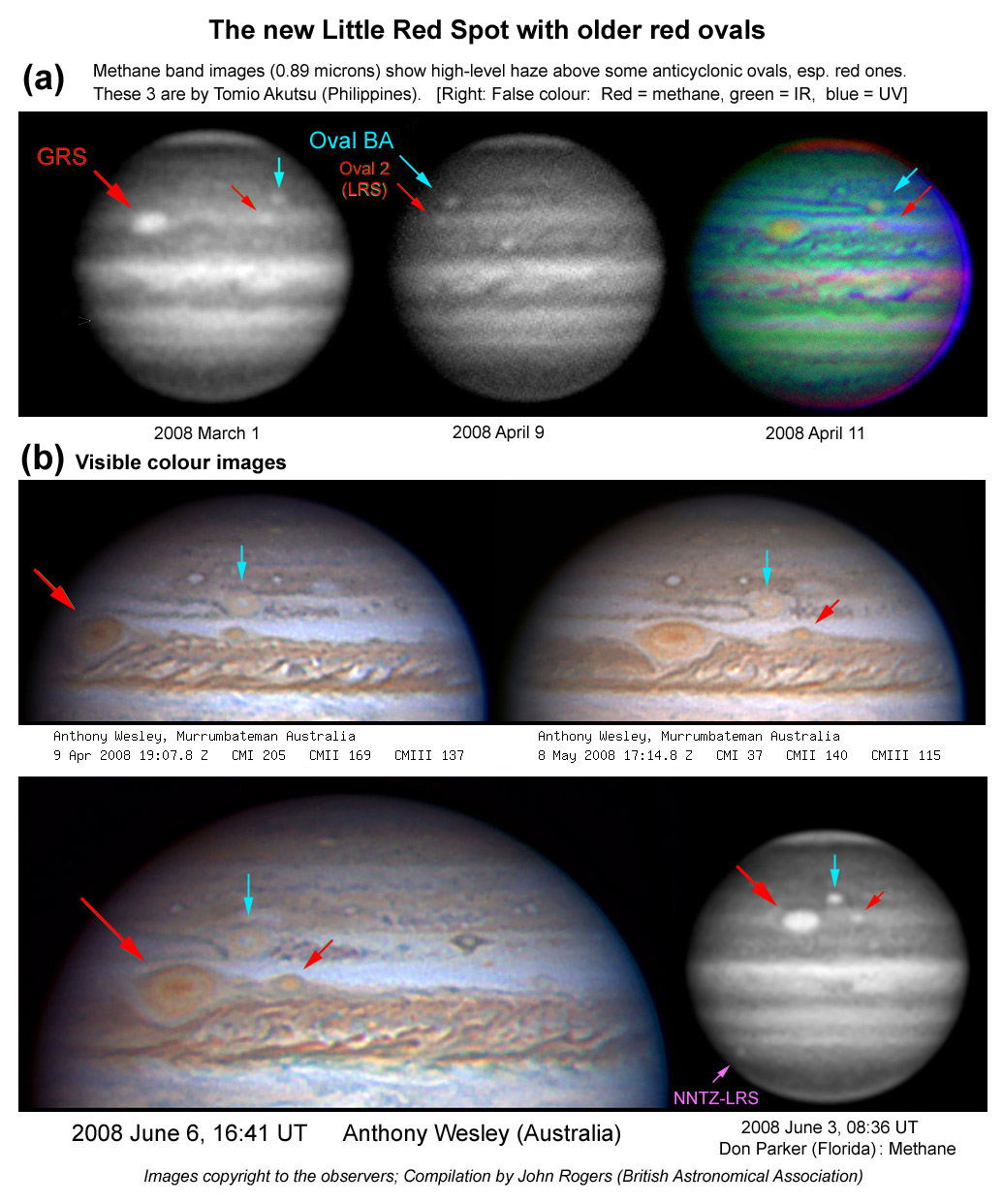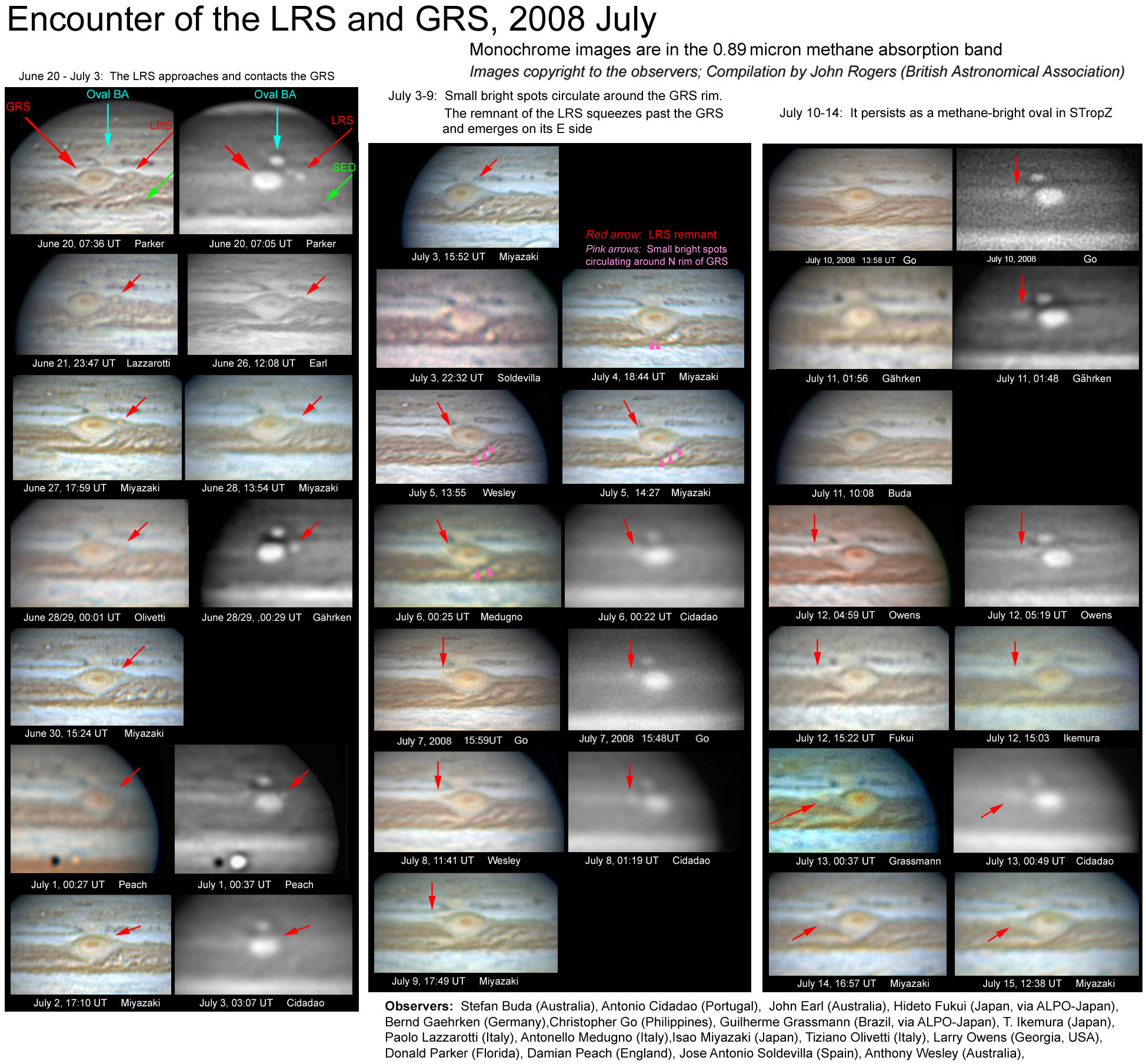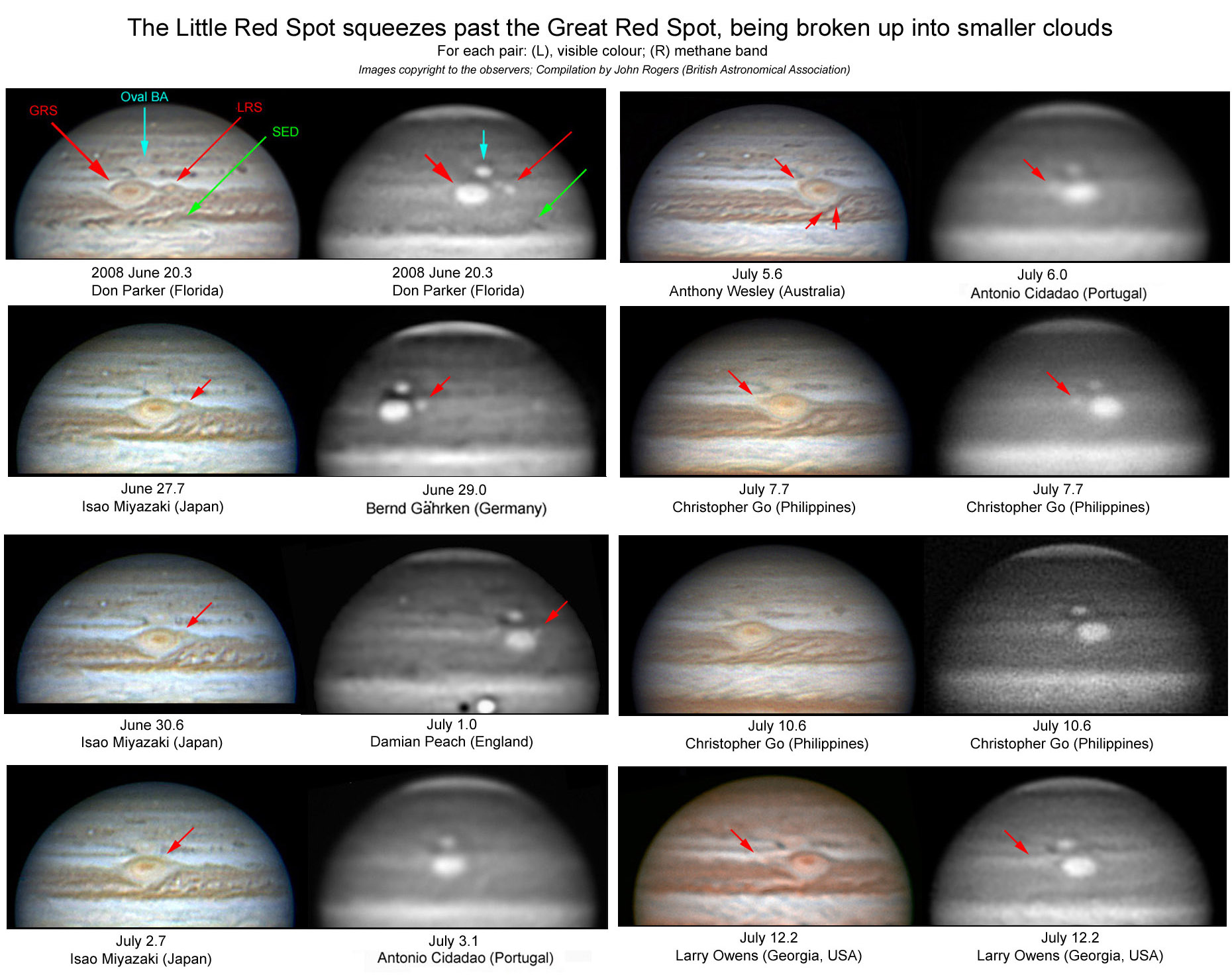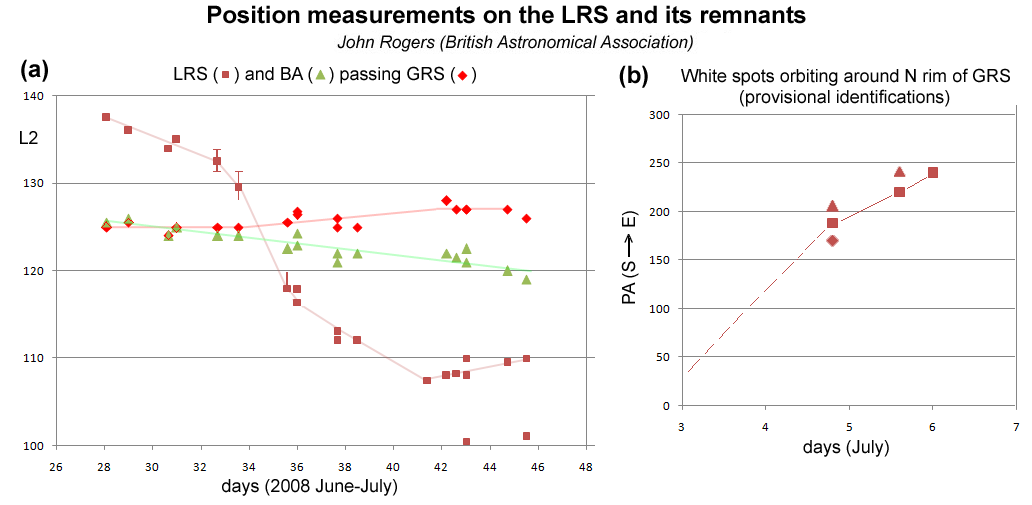
[4] The Aftermath of the GRS-LRS Encounter, 2008 July.
Jupiter
in 2008:
A
rare Little Red Spot squeezes ‘through the eye of a needle’.
John
H. Rogers, British Astronomical
Association
Non-Technical
Summary
This
month, astronomers have watched a very rare collision between Jupiter’s Great
Red Spot (GRS) and a smaller copy of it, a Little Red Spot (LRS). It happened
just as a third red spot, called Oval BA, was also passing alongside the GRS.
These ‘spots’ are huge anticyclones, whose reddish cloud colour may
indicate that they are particularly vigorous and deep-rooted. This was a unique
opportunity to see how Jupiter’s atmosphere would behave when they collided.
This report describes how amateur astronomers around the world have
produced a thorough record of the event.
As
the LRS approached the GRS from the west, it was suddenly swept up by the
powerful winds that circulate around the GRS, and within a few days it was being
shredded as it squeezed into the very narrow jet-stream that separated the GRS
from oval BA. Several fragments of
it emerged in the form of smaller white or orange spots.
Several of these were apparently caught up by the fastest winds around
the periphery of the GRS and performed almost a full circuit of the GRS before
disappearing. A slower-moving
remnant emerged east of the GRS and for a few days it again showed traces of the
reddish, high-altitude cloud layer that distinguished the original LRS; a white
remnant of this spot still persists a week later.
Background
Red
colour appears in Jupiter’s clouds in regions of very fast winds, or after
intense weather activity, or in exceptional anticyclones.
The GRS is the largest of these anticyclones and the only permanent red
oval. Smaller ones (LRSs) appear sometimes in other latitudes: in recent years
there has often been one in the NNTZ, and much attention was directed to a large
oval in the STZ (called Oval BA) when it turned reddish in 2006. We also reported a LRS in the NTZ in 1997-1998 [Ref.2], possibly similar
in origin to the present S. Tropical LRS.
The
present LRS appeared in the South Tropical Zone (STropZ), i.e. in the same
latitude as the GRS, which is very rare. The
only previous examples were in 1986 and 1990-93, and there was probably a
similar example in 1889-1890 [sic], very like the present one although colour
was not noticed at that time. [For details see Ref.1.]
The
present LRS was the latest result of an unusual tendency to eddying in the
STropZ, which has been noticed since summer 2006.
Last year this eddying was concentrated in two sites (called South
Tropical Disturbances: STrD’s), and one of these produced a dramatic spectacle
as it caused dark vortices travelling on a jetstream to perform U-turns.
During solar conjunction, the STrD’s disappeared leaving just two
ovals, which seem to be the outcome of all this eddying.
They were seen in 2008 Feb. at the start of the apparition.
One of these (which we called Oval 2) is the LRS – red, and bright in
methane-band images – as we first identified in images taken by Tomio Akutsu
(Philippines) and Anthony Wesley (Australia) on 2008 March 1-2. Its
length was about 3500 km.
Along
with those of 1986 and 1889-1890, it belonged to an uncommon class of ovals in
the STropZ, which arise from a STrD and
share its prograding motion (negative DL2).
Its speed (DL2) varied between -5 and -12 deg/month, and it was at 24.1
deg.S (+/- 0.45 deg., SD: JUPOS data from Hans-Joerg Mettig and colleagues).
All these properties distinguish these ovals from the more common class
of anticyclonic spots in the STropZ, which are slower-moving (typical DL2 ~ 0 to
+8), further north (typical latitude 23.3 deg.S, as in 1994 [ref.3] and
1999/2000/2001/2002 [our BAA reports]), and white or brown or ring-shaped but
never red. (There was one exception: a long-lived white spot which reddened in
1990 and 1993 along with the GRS as the SEB faded; it later collided with
the GRS, in 1997, although it was then white.)
It is not known why there are two classes of S. Tropical anticyclonic
ovals with different origins and properties.
The
LRS was drifting slowly towards the GRS (Figure
1). The GRS is a vast
anticyclone with a circulation period of 4.5 days [ref.4].
Other anticyclonic circulations in the STropZ have been observed
impinging on it in previous years:
1)
When the p. end of the great STrD (also an anticyclonic circulation)
encountered the GRS from the W, it used
to be swept round the S side very rapidly then re-form on the E (p.) side
[ref.5].
2)
Vortices on the SEBs jet-stream at
20 deg.S commonly encounter the GRS from the E and are swept around its N edge,
and their remnants may be merged into it, as was beautifully shown in the
Voyager movies.
3)
The larger ovals at 23 deg.S drift
slowly up to the GRS from the E, and the collision of one of these in 1997 was
observed in some detail [refs.2 & 3]. It was swept more slowly around the N
edge and part was then expelled to the N, though part was retained in the GRS
which continued disturbed for several months.
But
a LRS may be the most deep-rooted or vigorous of all anticyclones, and there had
been no opportunity to observe one of these colliding with the GRS – at least,
not since 1890. A century later, we
hoped that modern imaging would reveal the details of the interaction if and when this LRS encountered the GRS. We watched to see if it would accelerate
rapidly around the S edge of the GRS, and if so, whether it would merge with it
or pass by or be torn apart. Methane-band images
would be of interest: for example, to see whether the
methane-bright cloud cap of the LRS would disconnect from the underlying
vortex, as happened during the
merger of ovals BC and DE that formed oval BA.
And by coincidence, oval BA (which progrades relative to the GRS and
passes it every 2 years) was precisely alongside the GRS during the interaction.
Observations
All
the observations were from the worldwide network of amateur astronomers using
CCDs or webcams; many made great efforts
to record this phenomenon. With Jupiter at its furthest south, only
observers in the tropics or southern hemisphere were getting really good seeing.
Just as with the Circulating
Current observations exactly a year ago, the Australians had bad luck with
winter weather, but Isao Miyazaki on Okinawa managed to get good images almost
every night. Chris Go in the
Philippines was also especially involved in both making and interpreting
observations.
We
were keen to get images in the 0.89 micron methane band, to reveal the
high-altitude cloud cap that is always a feature of a LRS.
Tragically, Tomio Akutsu, the only observer taking regular methane
images, lost his telescope to a disastrous hurricane in the Philippines just a
week before the collision. But
Chris Go was able to fill the gap as he obtained a methane filter just in time
via Dr. Imke de Pater. We were also
very pleased that other observers came forward with methane images, including
Antonio Cidadao (Portugal) and Bernd Gaehrken (Germany) – and even Damian
Peach, who managed to get well-resolved methane images from England with the
planet only 16 deg. up. Caution
should be applied in interpreting these images, as observers use a variety of
methane filters with different bandwidths, and all except Go processed the
images for clarity; nevertheless, all the features mentioned here are present in
raw images.
Results
The
best images on each date are shown in Figure 2.
In late June, we noticed that the LRS was slightly
accelerating, and by June 28 it was very close to the W (f.) edge of the GRS
(separated by no more than the diameter of the LRS).
On June 30, Miyazaki’s image showed it was clearly accelerating to the southeast,
entrained by the rapid circulation around the edge of the GRS.
It was still a compact spot on July 1 (Peach’s methane image).
On July 2 it was stretched into a very narrow streak retaining some
slight reddish colour, moving around the GRS, and the remains of this were
probably still discernible on July 3 (in Cidadao’s methane image as a pale
fringe to the GRS, and in Miyazaki’s colour image).
By then it was squeezing very tightly into the jet-stream passage between
the GRS and oval BA, and we did not know whether we would see any trace of it
again.
The
first remnants to reappear were a string of 2 or 3 white spots lying obliquely
across the north rim of the GRS, imaged on July 4, and retrograding around the
N rim on July 5 and 6. [We only
identified them a few days later, re-examining the images after helpful
correspondence with Dr. Glenn Orton, Dr. Agustin Sanchez-Lavega, and Sean
Walker.]
They
probably originated when the LRS was shredded on July 2, and travelled half-way
around the GRS by July 4 – surprisingly fast for spots on the outer rim of the
GRS, but possible if they moved with the fastest GRS rotation period (4.5 days)
and its fastest wind speed (~ 180 m/s). From July 4 to 6, they travelled round
the rim with a more modest speed, ~80 m/s (Figure
3b). On July 7 the white
clouds had apparently ended up in the formerly dark triangle at the W (f.) end
of the GRS.
(One
may also note that the f. half of the GRS was less methane-bright on July 3,
then slightly greyish in the colour images of July 4 & 5.
However these subtle variations may not have been effects of the
collision.)
Meanwhile,
on July 5-6, as Far Eastern observers reported with excitement, reddish material
began to re-emerge from the passage on the SE side of the GRS, and again
comprised a methane-bright patch: some remnant of the elevated red cloud-deck of
the LRS seemed to have survived the passage!
A longitude chart (Figure
3a)
shows that the LRS accelerated smoothly around the GRS and the remnant
decelerated symmetrically on the other side, having reached a speed of ~ -4.8 to
6.8 deg/day (64-94 m/s) (relative to System 2 and the GRS). (This is ~ 60-90 m/s
relative to System 3, less than the rotation speed of the GRS, but more than the
mean speed of the STBn jet which is 44 m/s.)
On
July 7 and 8, this ‘LRS remnant’ was a distinct compact methane-bright spot,
prograding away from the GRS, even though it was fading in visible light –
just a pale orange smudge on July 7 and barely perceptible on July 8 and 9,
although its f. edge was marked by a very dark grey streak being drawn out from
the GRS rim.
On
July 10 and 11, it looked as though the re-emerged LRS remnant was dissipating,
as the orange patch had faded and the methane-brightness appeared diffuse over
this whole region of STropZ. But
this was only temporary and the ‘LRS remnant’ apparently has survived
through July 12-14, as a distinct spot which is white (July 12) or reddish (July
13-14) and methane-bright. It is
slightly further north than before, and nearly stationary at L2 = 108 (~10 deg.
p. the edge of the GRS, but probably now drifting back towards it). So it may be
a vortex that has settled down into the position of the slow-moving, non-red
class of ovals.
(Note
that the very bright white spot just p. it is a pre-existing spot – one of a
series of bright bays and dark streaks in this band, drifting towards the GRS at
DL2 = +1.0 deg/day according to a JUPOS chart.)
Discussion
These
observations show that the LRS was rapidly entrained by the GRS circulation and
probably broke up on July 2, producing a group of white spots which circulated
very rapidly most of the way around the GRS rim, and a slower-moving spot which
emerged on the E(p.) side into the STropZ.
These may all have been fragments of a single disruption, those closest
to the GRS moving around it fastest. However
it is not clear from the present observations whether the LRS was sheared
horizontally (by radius from the GRS) or vertically (with ‘cap
disconnection’) or both. Methane-band
images on July 1-3, before the conjunction, did
not fully resolve the LRS but suggested no cap disconnection.
We cannot say whether the white spots which moved around the rim on July
4-6 carried methane-bright caps, as they could not have been resolved from the
methane-bright GRS. The spot which emerged p. the GRS on July 5-6 did retain or
re-form some of the high-level, orange, methane-bright cloud cap, and although
it was unstable at first, it seems to have evolved rapidly since July 11 into an
anticyclonic oval with a methane-bright cap and slight reddish colour.
Therefore, this spot probably carried anticyclonic vorticity with it and
represents the main part of the LRS.
Fortunately,
professional observers were able to obtain v-hi-res images with HST and with IR
observtories during the event, so they may have data to show more of what
happened to the vorticity of the LRS, and to its clouds at different levels.
We
will continue to look for effects on the GRS.
Figure 3a indicates that the GRS longitude (L2) increased from 125 to 127
just after the event. This could be
a reaction to the passage of the LRS, or it could just be the regular peak of
the 90-day longitude oscillation, which is due at this time: this will be
clearer when the next JUPOS chart is prepared.
We
can also look for any effects on oval BA and the STBn jet-stream.
So far there are no obvious effects on either.
Oval BA passes the GRS every 2 years without lasting effect, though there
are often albedo changes in the surrounding STB as it does so.
The STBn jet-stream was generating small dark vortices p. oval BA/GRS
well before the LRS arrived, and has not produced any new spots nor any obvious
deflection due to the LRS. We will
look out for any change in jet speed during the coming weeks.
This event is perhaps the best possible test of whether a prograde jet
can be perturbed, as a substantial vortex was rammed into the jet between two
very large stable anticyclones in close proximity. Prograde jets on Jupiter are almost never perturbed by
visible weather systems, and this event may put new limits on their
imperturbability.
References:
1.
Rogers JH (1995) ‘The
Giant Planet Jupiter’ pp.197, 200, 206 (Camb. Univ. Press).
2.
Rogers JH (2001), ‘Jupiter in 1997’, JBAA 111, 186-198,
& (1997) JBAA 107,
333-335 [interim report]
3.
Sanchez-Lavega A et al.(1998) Icarus
136, 14-26.
4.
Rogers JH (2008), JBAA 118,
14-20.
5.
Peek BM (1958) ‘The Planet Jupiter’ (Faber & Faber)
_
_ _ _ _ _ _ _ _ _ _ _ _ _ _ _ _ _ _ _ _ _ _ _ _ _ _ _ _ _ _ _
Figures:

Figure
1.
Some
images showing the new Little Red Spot, close to Oval BA and approaching the GRS.
The top row and the final image are in the methane absorption
band, showing all three red ovals as methane-bright spots.

Figure
2.
(A)
A complete set of the best image(s) on each date during the event.
Monochrome images are in the methane absorption band.
Red arrow indicates the LRS and its remnants.

(B)
A selection of the best images, showing more of the planet.
Left, visible colour; right, methane band. Red arrows indicate the LRS
and its remnants.

Figure
3.
Charts
showing the motion of the LRS and its remnants.
(a)
Longitudes in System II.
(b)
Position angle for the small white spots on the rim of the GRS, July 4-6.
Position angle was measured from S to E after stretching the GRS image to
be approx. circular. Uncertainty +/-
10-15 deg.
[Notes:
South is up in all figures. If anyone needs a version with north up, or with less
compression, ask and I may be able to provide them. All images are copyright to the observers, and the
compilations to JHR, but we will be happy to respond to reasonable requests to
reproduce them.]